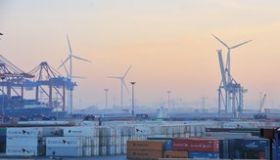G20 Topics and Hamburg
NEW 4.0: Test run for the energy transition

An energy system of the future will be developed in Northern Germany as part of the large-scale project NEW 4.0. From 2035, around 4.5 million residents in the federal states of Hamburg and Schleswig-Holstein will be provided with power by renewable energy sources alone. Applying Industry 4.0 systems, the project will demonstrate how imbalances in production and consumption can be offset based on renewable energies.
Hamburg, capital of wind energy

The Hamburg Metropolitan Region is already one of the main centres for renewable energy in Europe. Among industry experts and beyond, Hamburg is considered to be the international wind energy capital. Today, two thirds of the global know-how in wind energy are located in the Hamburg Metropolitan Region and the neighbouring region encompassing the federal state of Schleswig-Holstein and Jutland, Denmark. In the Hamburg Metropolitan Region, some 25,000 people work for nearly 1,500 renewable energy companies. The most important contribution to this has been made by wind energy players. Many of the wind industry’s global players, such as DONG Energy, Nordex, Senvion, Siemens and Vestas, have their head offices in Hamburg.
SmartPORT Hamburg

Ports are both the backbone and an indicator of today’s challenges in global trade. Finding the right balance between economy and ecology has become a key issue for ports all over the world. The port of Hamburg is tackling these challenges through intelligent port management solutions. Today’s world of globalisation and climate change requires creativity and alternative actions to achieve sustainable economic growth with as little impact on the environment as possible.
Refugee First Response Center

Language is a key factor for medical aid. That’s why the team of the Refugee First Response Center (RFRC) has transformed conventional shipping containers into medical stations including medical equipment, a network connection and HD video conferencing facilities. These allow doctors and other medical staff to interact with their patients through a highly flexible interpreting service – enabling refugees to communicate in their own language and thus receive more efficient medical assistance. As part of this project, interpreters for about 50 languages are available quickly via live video broadcasting, helping doctors and patients communicate with each other better and faster.
One Belt – One Road

Hamburg regards itself as a central hub for the sea and overland routes of the New Silk Road that will be part of the Chinese government’s “One Belt – One Road” initiative. The idea of the New Silk Road continues Hamburg's centuries-old tradition as a Hanseatic city as regular ship departures from Hamburg to the east coast of China can be traced back to the mid-18th century. Hamburg has maintained close relations with its Chinese partner city of Shanghai since the 1980s. Hamburg and China are linked in various ways, and a growing number of freight train connections to other regions within the People’s Republic is being developed in addition to existing sea routes.
Infectious diseases

MERS, Ebola, Zika – these and other threatening infectious diseases came under the spotlight at the recent European Congress of Virology. The event, which took place in Hamburg in October 2016, is considered to be the most important gathering for virus researchers in Europe. Considering the recent advances in the diagnostics of Zika that have been made in the region, Hamburg was certainly an apt location for this global conference. Researchers and companies from Northern Germany’s life sciences sector operate at the forefront of the response to epidemics; they provide tools for detecting and understanding complex viruses and examine e.g. how diseases can be spread by different mosquito species.